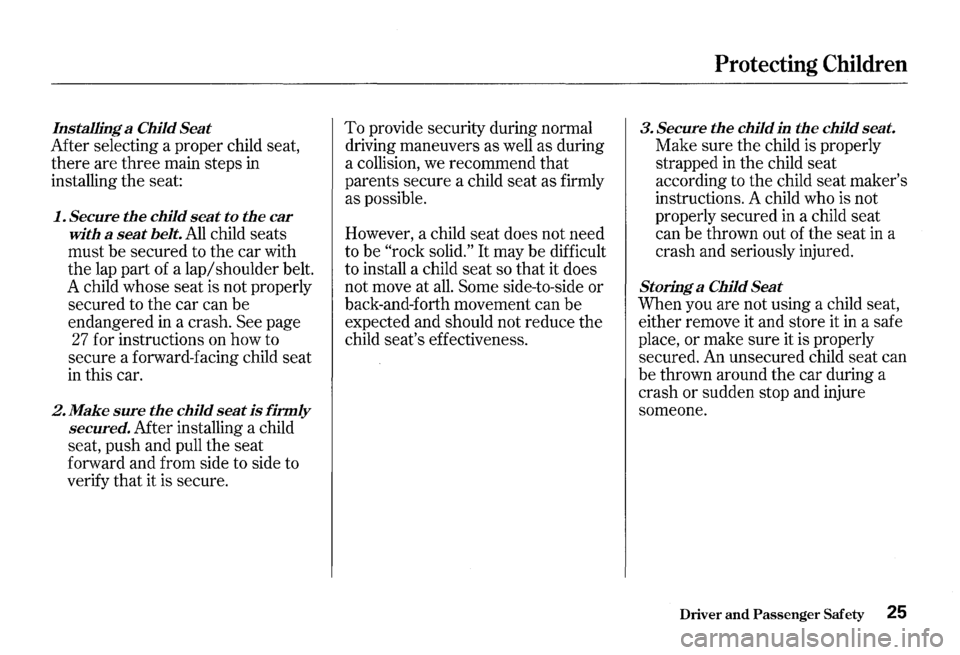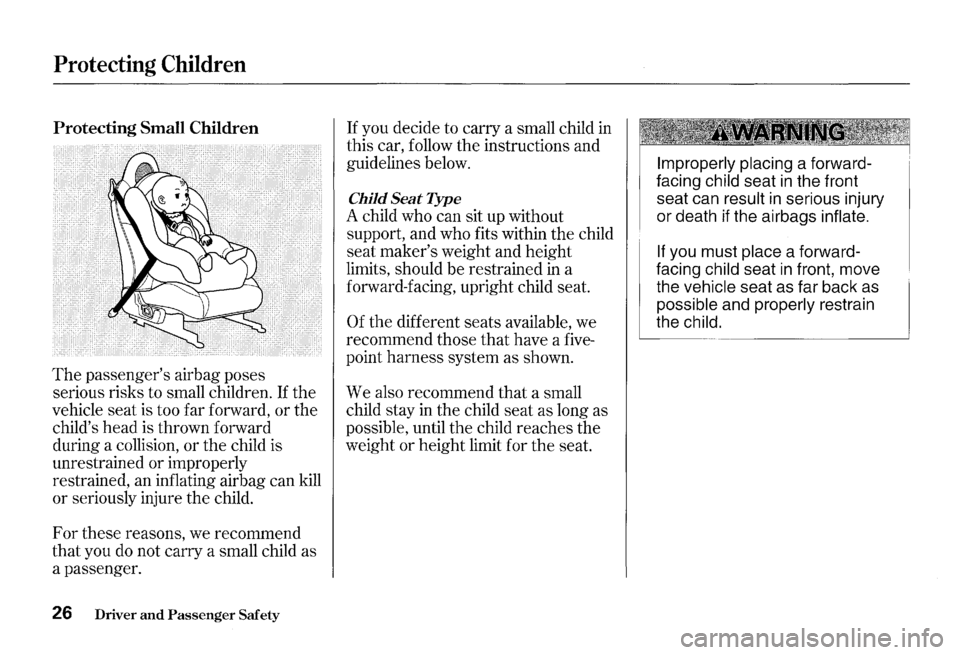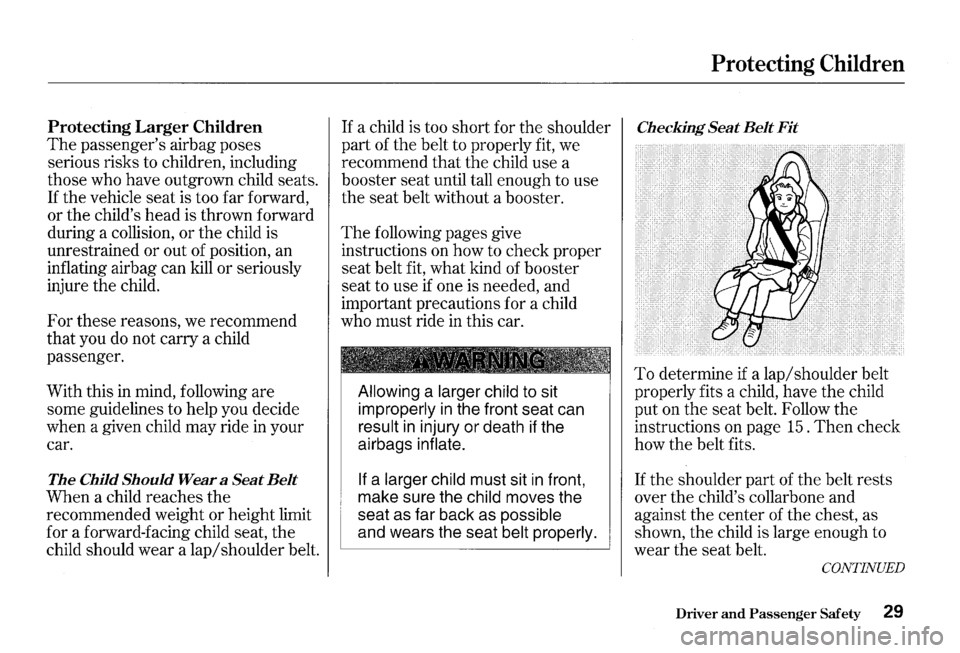Page 25 of 273

Protecting Children
Additional Safety Precaution
• Do not leave a child alone in your
car. Leaving a child without adult
supervision is illegal
in most states
and Canadian provinces and can
be very hazardous. For example, a
small child left
in a car on a hot
day can die from heatstroke. A
child left alone with the key in the
ignition can accidentally set the
car
in motion, possibly injuring
themselves
or others.
22 Driver and Passenger Safety
General Guidelines for Using
Child
Seats
As discussed on page 20, because
your car does not have a back seat,
and because
of the passenger's
airbag hazard, we strongly
recommend that you
do not carry a
small child as a passenger
in this car.
However,
if you must carry a small
child
in this car, the child must be
properly restrained in a child seat.
The following pages give general
guidelines for selecting and installing
a child seat.
See page 26 for
additional information.
Selecting a Child Seat
To provide proper protection, a child
seat should meet three
requirements:
1. The child seat should meet safety
standards. The child seat should
meet Federal Motor Vehicle
Safety Standard
213 (FMVSS 213)
or Canadian Motor Vehicle Safety
Standard
213 (CMVSS 213). Look
for the manufacturer's statement
of compliance on the box and seat.
Page 26 of 273
2. The child seat should be of the 3. The child seat should fit the
proper type and size to fit the child. passenger's seat.
Small Children: A child who can sit
up without support should be
restrained in a forward-facing child
seat.
See page 26 for additional
information on protecting small
children. Due
to variations
in the design of
child seats, vehicle seats, and seat
belts,
all child seats will not fit all
seating positions in all cars.
However, Honda is confident
that
one or more child seat models can fit
and be properly installed in all
recommended seating positions
in
your car.
Protecting Children
Before purchasing a child seat, we
recommend
that parents test the
child seat to make sure it fits
properly
in the passenger's seat. If a
previously purchased child seat does
not fit, you
will need to buy a
different one that will fit.
CONTINUED
Driver and Passenger Safety 23
Page 28 of 273

Installing a Child Seat
Mter selecting a proper child seat,
there are three main steps in
installing the seat:
1. Secure the child seat to the car
with a
seat belt. All child seats
must be secured to the car with
the lap part of a lap/shoulder belt.
A child whose seat is not properly
secured to
the car can be
endangered
in a crash. See page
27 for instructions on how to
secure a forward-facing child seat
in this car.
2. Make sure the child seat is firmly
secured. Mter installing a child
seat, push and pull the seat
forward and from side to side to
verify that it is secure. To
provide security during normal
driving maneuvers as well as during
a collision, we recommend that
parents secure a child seat as firmly
as possible.
However, a child seat does not need
to be
"rock solid." It may be difficult
to install a child seat so that it does
not move at
all. Some side-to-side or
back-and-forth movement can be
expected and should not reduce the
child seat's effectiveness.
Protecting Children
3. Secure the child in the child seat.
Make sure the child is properly
strapped in the child seat
according to
the child seat maker's
instructions. A child who is not
properly secured in a child seat
can be thrown out of the seat
in a
crash and seriously injured.
Storing a Child Seat
When you are not using a child seat,
either remove it and store it in a safe
place, or make sure it is properly
secured. An unsecured child seat can
be thrown around the car during a
crash or sudden stop and injure
someone.
Driver and Passenger Safety 25
Page 29 of 273

Protecting Children
Protecting Small Children
The passenger's airbag poses
serious risks to small children.
If the
vehicle seat is too far forward, or the
child's head is thrown forward
during a collision, or
the child is
unrestrained or improperly
restrained, an inflating airbag can kill
or seriously injure the child.
For these reasons, we recommend
that you
do not carry a small child as
a passenger.
26 Driver and Passenger Safety
If you decide to carry a small child in
this car, follow the instructions and
guidelines below.
Child Seat Type
A child who can sit up without
support, and who fits within the child
seat maker's weight and height
limits, should be restrained
in a
forward-facing, upright child seat.
Of the different seats available, we
recommend those
that have a five
point harness system as shown.
We also recommend that a small
child stay
in the child seat as long as
possible, until the child reaches the
weight or height limit for the seat.
Improperly placing a forward
facing
child seat in the front
seat can
result in serious injury
or death if the airbags
inflate.
If you must place a forward
facing
child seat in front, move
the
vehicle seat as far back as
possible and properly restrain
the
child.
Page 32 of 273

Protecting Larger Children
The passenger's airbag poses
serious risks to children, including
those who have outgrown child seats.
If the vehicle seat is too far forward,
or the child's head is thrown forward
during a collision, or the child is
unrestrained or out of position, an
inflating airbag can kill or seriously
injure the child.
For these reasons, we recommend
that you
do not carry a child
passenger.
With this
in mind, following are
some guidelines to help you decide
when a given child may ride in your
car.
The Child Should Wear a Seat Belt
When a child reaches the
recommended weight or height limit
for a forward-facing child seat, the
child should wear a lap/shoulder belt.
If a child is too short for the shoulder
part of the belt to properly fit, we
recommend that the child use a
booster seat until tall enough to use
the seat belt without a booster.
The following pages give
instructions on how to check proper
seat belt fit, what kind of booster
seat to use
if one is needed, and
important precautions for a child
who must ride in this car.
Allowing a larger child to sit
improperly in the front seat can
result in injury or death if the
airbags
inflate.
If
a larger child must sit in front,
make sure the
child moves the
seat as far back as
possible
and wears the seat belt properly.
Protecting Children
Checking Seat Belt Fit
To determine if a lap/shoulder belt
properly fits a child, have the child
put on the seat belt. Follow the
instructions on page 15.
Then check
how the belt fits.
If the shoulder part of the belt rests
over the child's collarbone and
against the center of the chest, as
shown, the child is large enough to
wear the seat belt.
CONTINUED
Driver and Passenger Safety 29
Page 70 of 273
Console Compartments
The area between the seats has two
compartments.
Open the lower
compartment by squeezing the
handle.
Close it with a firm push.
You can lock or unlock the lower
compartment with the master key.
The lever to open the upper
compartment is inside the lower
compartment.
Push up the lever and
lift the
lid. To close, lower the lid and
push it down until it latches.
Keys and Locks
Instruments and Controls 67
Page 71 of 273
Seat Adjustments
See pages 12 -13 for important safety
information
and warnings about how to
properly position seats
and seat-backs.
Make all seat adjustments before
you start driving.
To adjust the seat forward and
backward, pull up on the lever under
the seat cushion's front edge. Move
the seat to the desired position and
release the lever.
Try to move the
seat to make sure it is locked
in
position.
68 Instruments and Controls
To change the angle of the seat-back,
pull up on the lever on the outside of
the seat bottom. Move the seat-back
to the desired position and release
the lever. Let the seat-back latch in
the new position.
Page 128 of 273
Load Limit
The maximum load for your car is
400 lbs (185 kg).
This figure includes
the total weight
of
all occupants, cargo, and
accessories.
To figure out how much cargo you
can carry:
• Add up the weight of all occupants.
• Subtract the total from 400 lb (185
kg).
The final number is the total weight
of cargo you can carry.
Overloading or improper
loading can affect handling and
stability and cause a crash in
which you can be hurt or killed.
Follow all load limits
and other
loading guidelines in this
manual.
Carrying Cargo
Carrying Items in the Passenger
Compartment
• Store or secure all items that could
be thrown around and
hurt
someone during a crash.
• Be sure items placed on the floor
behind the front seats cannot roll
under the seats and interfere with
the driver's ability to operate the
pedals, or with the proper
operation of the seats.
Before Driving 125